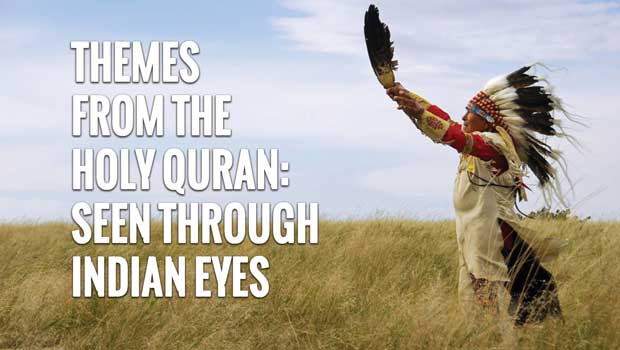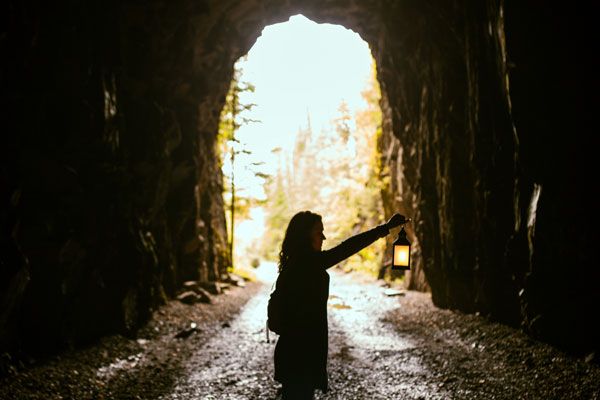Editor’s note: The following is a slightly modified version of an article that first appeared in The Message in 1996. The author finds similarities between Native American beliefs and values and those of Islam. This is useful in that it can promote mutual understanding between the two communities. It can also help those Muslims who are engaged in Dawah (outreach) to Native Americans. Native American religious beliefs are somewhat diverse but, for the most part, convey a pantheistic view of God, seeing God as the only reality, as Creator but also indwelling in the creation. Islamically, the distinction between the Creator and the creation is absolute, clear, and unassailable. While divinity is not found in the created world, the signs of God are everywhere — all pointing to His existence, His sovereignty, power, and glory.
The ‘Original Instructions’
Indian traditions refer to “The Original Instructions,” teachings given by the Creator at the dawn of time. It corresponds [in some ways] to the Islamic idea of din ul-fitr. The Quran tells us, “Devote yourself completely to faith, and adhere to the natural pattern in which He created mankind. There is no altering of the laws of God’s creation. That is the right religion, but most of mankind doesn’t understand that” (30:30). “Original Instructions” does not refer to a set of doctrines or rituals, but rather to remembering God always and trying to follow His guidance, practicing responsibility, and having compassion for all creatures. It also teaches self-sufficiency and generosity and learning about God’s laws through His creation.
The phrase — “Do everything in a sacred manner” — is often heard among Indians. It involves direct experience with God and His creation, rather than abstract reasoning. Bringing remembrance of God to every word and action is a devotion that leads to the light. As the Quran says, “There shall be no compulsion in religion. Surely right has become distinct from wrong. So, whoever rejects evil and believes in Allah has surely grasped a strong handhold which will never break. And Allah is all-hearing, all-knowing. Allah is the protector of those who believe; He leads them out of every kind of darkness into light. And those who disbelieve, their patrons are the transgressors who bring them out of light into every kind of darkness” (2:256-257).
The Original Instructions are not universally followed in Indian communities. Over the centuries extraneous beliefs and practices have sometimes gotten mixed into Native American religions, sometimes with good results, sometimes not. Prior to the 1492 invasion, we were exposed to Middle Eastern paganism and sun-worship, and elements from British Isles witchcraft. Since the invasion, we have seen many Indians adopt various Christian creeds. There are also a few Indian Buddhists and Muslims, and quite a number of Baha’i and Mormons. In addition, there is the “New Age” culture and spirituality superimposed upon, or mixed with, materialism, group therapy, and occultism (involving power-seeking, ritual magic, and sometimes a pantheon of gods from all over the world). There are now Indians calling for a return to the Original Instructions, and a weeding out of extraneous, and sometimes corrupting, ideas from our traditions.
Seeing Signs of God in Creation
God says in the Quran, “In the heavens and the earth are signs for those who believe. And in the creation of yourselves and the animals scattered throughout the earth are signs for those with sure faith; also, in the alternation of night and day, and the sustenance that God sends down from the sky and thereby revives the earth after her death, and the ordering of the winds, are signs for a people who have sense” (45:3-5). Indians have always seen the signs of God in nature and in the world around them. Walking Buffalo (a Stoney Indian) has said, “We saw the Great Spirit’s [God’s] work in almost everything: the sun, moon, trees, wind, and mountains.… I think we have a true belief in the supreme being… Indians living close to nature and nature’s ruler are not living in darkness.” Tom Flanders wrote in The Eagle (a New England Indian newspaper): “Traditionalists know what is right… they know the Creator even though we cannot understand this force which is so much more powerful than our experience. Because we are close to everything that God has made, we are close to God. We know that an offense against any part of creation is an offense against the Creator and against ourselves.”
Man’s Relationship to Nature
The Quran tells us, “There is not an animal on earth or a winged creature that flies but are communities like you. We have left nothing out of the Book. They shall all be gathered to their Lord” (6:38). And in another verse, God says, “Don’t you see that it is God whom all beings in the heavens and on earth praise, and the birds of the air with outspread wings? Each knows its own manner of prayer and praise, and God is aware of all that they do” (24:41).
Black Elk (Oglala Sioux), in the introduction to his autobiography, stated: “My friend, I am going to tell you the story of my life… It is the story of all life that is holy and is good to tell, and of us two-leggeds sharing in it with the four-leggeds, and the wings of the air and all green things…” Various Indian expressions reflect this relationship to God’s creatures. The Sioux phrase, “mitakuye oyasin” (all my relations) refers to other creatures of earth as brothers and equals before God. Then there is the philosophy of “respect” among all Indians – that God’s creatures are to be respected as brothers, not as servants; as equals, not as inferiors; as respected fellow travelers along the path of God; and as teachers…”
Three Eagles, Band Chief of the United Southwestern Allegheny Nations, has said: “To Native Americans, spiritual refinement and practice is normal. Before Amerindian culture was so disrupted by the devastation of unpracticed values, diseases, and invasion it was commonplace to develop the gifts of communicating with all life. It is still practiced some today by those who have kept or recovered their knowledge. With it goes a tremendous responsibility to keep in balance.” Floyd Westerman (Oglala Sioux songwriter, actor, and activist) points to the fact that the Indian worldview is not political, ideological, or materialist: “… the Indian world point of view is neither left nor right, communism or capitalism, because Indian culture is based on spirituality.”
Righteousness
The Quran tells us, “Righteousness is not turning your faces towards East or West. Rather, righteousness is to believe in God, and the Last Day, and the angels and the Scriptures, and the Prophets. To give your wealth out of love for Him to kin and orphans, and to the needy and the travelers, and to those who ask it; and to free slaves, to be steadfast in prayer, pay charity for the poor, to keep promises when you make them; and to be patient in suffering and hardship and during times of stress. Such as those who are sincere; the ones who are God-fearing” (2:177).
The Iroquois Creed as quoted by Chief Three Eagles (United Southwestern Allegheny Nation) describes the beliefs and values of the Iroquois who “…believed in…a life everlasting, and in the fraternity of life. With an Iroquois, a thankful heart was prayer… he believed that it was natural to be honorable and truthful, and cowardly to lie. His promise was absolutely binding… He believed in reverence for his parents, and in old age supported them, even as he expected his children to support him… he believed in a forgiving spirit, preferring atonement to revenge…in converting enemies to friends. He believed in the sacredness of property; theft among early Indians was unknown… He believed in the equality of women…”
The Two Paths
The Holy Quran mentions the path of the believer in contrast with the path of those who reject God: “…And what will explain to you the steep path? It is freeing the bondsman or giving food in a time of difficulty to an orphan of near relationship or to the indigent in the dust. Then he will be one of those who believe and encourage steadfastness and compassion. Such are the companions of the right-hand. But those who reject our revelations, they are the companions of the left; they will be covered over with fire” (90:12-20).
The scholar Joseph Epes Brown, in “The Sacred Pipe— Black Elk’s Account of the Seven Rites of the Oglala Sioux,” notes: “The red road is… the good or straight way…similar to the Christian straight and narrow way; or the as-siratal mustaqim of the Islamic traditions. On the other hand, there is the ’blue’ or ’black road’ of the Sioux… which is the path of error and destruction. He who travels on this path is, Black Elk has said, ’one who is distracted, who is ruled by his senses, and who lived for himself rather than for his people.’”
Race and Color
The Quran says, “Among His signs is the creation of the heavens and the earth, and the variations in your languages and colors. In that are signs for those who have knowledge” (30:22). And in other verses we are told, “Do you not see that God sends down rain from the sky to bring forth produce of various colors? And in the mountains are streaks of white and red of various shades, [some] intense black. And so, people, animals, and livestock are various colors. Those among God’s servants who truly reverence Him have knowledge. For God is mighty and forgiving” (35:27-28).
Native Americans today are a variegated group, culturally Indian, whose ancestors include Europeans, Africans, Asians, Polynesians, and others. Because of this, there are Native American tribal members who range from light-skinned and blue-eyed to dark-skinned and brown eyes, in addition to those who look “typically Indian.” This diversity, coupled with the Bureau of Indian Affairs’ (BIA) insistence on “defining” who is an Indian, has led to considerable debate among Indians regarding who is an Indian: full-blood vs. mixed blood; reservation vs. off-reservation dwellers; traditionalists vs. moderns; tribal members vs. non-members in a BIA-recognized tribe. Recently, however, there has been a growing movement among Indians to define ourselves — as people who have Native American ancestry, who try to live by traditional values, and who are loyal to, and serve, the Native American people.
Charity/Zakat
In most Indian traditions, accumulation of wealth is not a legitimate goal, and greed and acquisitiveness are considered unworthy behavior. There is the Plains Indian tradition of the “give-away” where someone, on a special occasion, would give away food and personal possessions to those assembled. These events represent the Native American values of sharing, community, interdependence, and mutual well-being. They provide opportunity to distribute wealth among community members. In Islam, zakat is one of the five pillars and is not only an act of worship, it is a purifying of one’s wealth and a way to help those who are needy.
Gratitude
The theme of gratitude to God is presented again and again throughout the Holy Quran. Here is one example: “It is He Who brought you forth from the wombs of your mothers when you knew nothing; and He gave you hearing and sight and intelligence and affection that you may give thanks (to God)” (16:78). Gratitude to God for life, sustenance, and for all creation, is an essential part of Native American philosophy.
Jihad and the Role of the Warrior
“Those who believe and leave their homes [for the cause of God] and strive in the cause of God with their property and their persons, have a greater rank with God; they are the ones who are triumphant” (Quran 9:20). The word in Arabic that means “war” is “harb.” Jihad means struggling or striving in all ways to attain good as part of one’s devotion to God and Islam. Military action, when necessary, is but a part of that devotion. Likewise, the concept of “warrior” in Native American culture is not synonymous with “soldier.” A warrior is one who protects God’s creatures and his people, and who defends what is right. An Inuit (Alaskan native) woman, Nilak Butler, wrote the following:
Our suffering is small
Several moons ago my younger brother asked
With sorrow and sadness in his heart,
Why our family must suffer so much, sacrifice much.
And I thought on this,
Knowing that no answer at that time could ease his heavy heart…
Our family has made commitment to serve the People.
We struggle and resist— we are warriors.
And sometimes the prices we must offer
Are not as we would have thought them to fall.
Our family has made commitment
To honor and Protect Mother Earth
And all her children— all life.
And when I look at how she suffers,
In comparison our suffering is small.
Prayer
It is common among Native Americans to have a time of quiet prayer, “seeking the face of God” (i.e., the presence of God) morning and evening, to try to be conscious of His presence constantly, and to try to obey His laws and guidance. Here is an often-quoted prayer that was printed on a bookmark I received from the Red Cloud Indian School in Pine Ridge, South Dakota (author not given):
An Indian Prayer
O Great Spirit, whose voice I hear in the winds,
And whose breath gives life to all the world.
Hear me! I am small and weak.
I need your strength and wisdom.
Let me walk in beauty,
And make my eyes ever behold the red and purple sunset.
Make my hands respect the things you have made,
And my ears sharp to hear your voice.
Make me wise so that I may understand things you have taught my people.
Let me learn the lessons you have hidden in every leaf and rock.
I seek strength, not to be greater than my brother.
But to fight my greatest enemy— myself.
Make me always ready to come to you
With clean hands and straight eyes.
So, when life fades, as the fading sunset,
My spirit may come to you without shame.
Prayer, in Islam, is one of the five pillars of the religion. God says in the Quran, “Lo! In the creation of the heavens and the earth, and the alternation of night and day, there are signs for those who possess understanding; those who commemorate the praise of God standing, sitting, and lying on their sides, and reflect upon the creation in the heavens and the earth…” (3:190). And in another verse God says, “And be steadfast in prayer, practice regular charity, and bow down your heads with those who bow down [in worship]” (Quran 2:43).





